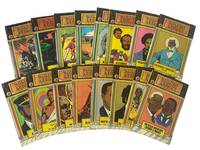by LGBTQ, AIDS Crisis
[LGBTQ] [Marginalized Groups] AIDS crisis archive of eight pieces, including seven press photographs and one informational booklet documenting critical social, medical, and political responses to the AIDS crisis, 1988–1993. This collection captures a range of public figures, activist movements, and institutional actions across the U.S. and internationally, representing a pivotal era in the HIV/AIDS pandemic and its intersection with issues of race, celebrity, medical ethics, and global health diplomacy. The archive includes:
[1] AIDS Medical Guide: A Series of Handbooks for People with AIDS. San Francisco: San Francisco AIDS Foundation, revised 1988. Stapled booklet, 8vo. Produced by one of the most prominent advocacy and services organizations of the epidemic, the handbook reflects efforts to disseminate accessible, multilingual information to patients in crisis, especially within the city’s LGBTQ and immigrant communities.
[2] Press photograph of AIDS activists protesting at Mass General Hospital, March 24, 1988. Silver gelatin photograph by Steven LaBadessa showing AIDS activists marching outside Massachusetts General Hospital with signs reading “WITHHOLDING MEDICATION IS MURDER” and “SURVIVED PCP? NO THANKS TO YOU MGH.” This photograph reflects the urgency and desperation of ACT UP-era protest movements confronting medical institutions over restricted access to experimental treatments.
[3] Press photograph of Dr. Lawrence Feldman with HIV-1 and HIV-2 research, January 28, 1988. Press photograph from Newark, NJ, featuring Dr. Lawrence Feldman of the University of Medicine holding comparative images of the HIV-1 and HIV-2 viruses. Feldman’s demonstration marks the first U.S.-reported case of HIV-2, an important milestone in the medical understanding of the virus’s variants.
[4] Press photograph of an AIDS Awareness poster featuring two men shaking hands with the caption "This is not an introduction to AIDS.", August 6, 1988. Photograph by Jon Olson representing grassroots public health outreach at the height of U.S. epidemic anxieties.
[5] Press photograph of Magic Johnson leaving a press conference shortly after publicly announcing his HIV status, November 6, 1992. Reuters press photo of NBA player Magic Johnson and his wife Cookie Johnson leaving a press conference after his second retirement from professional basketball due to his HIV-positive status. Johnson’s public disclosure became a watershed moment in changing public perceptions of HIV/AIDS and masculinity in sports.
[6] Press photograph of Arthur Ashe published upon his death from AIDS-related complications. Associated Press photograph dated April 1992 and republished February 1993 showing tennis legend Arthur Ashe, who publicly revealed his AIDS diagnosis in 1992. The attached caption notes his death at age 49 on February 6,1993. Ashe was a trailblazer both in tennis and in public health advocacy, particularly for Black Americans affected by HIV/AIDS.
[7] Press photograph of Princess Diana of Wales at the 2nd International Conference on HIV in Children and Mothers, August 8, 1993. Press photo by Chris Bacon capturing Princess Diana addressing the 2nd International Conference on HIV in Children and Mothers in Edinburgh. Diana’s outspoken compassion toward people with AIDS helped reduce stigma during a time of widespread public fear and misinformation.
[8] Undated press photo labeled “AIDS CONFERENCE” featuring a delegation of African and Cuban officials at a UNESCO-associated meeting, likely in the late 1980s or early 1990s. It documents the international diplomatic response to the pandemic and the efforts of Global South nations to assert a voice in the global health conversation.
Mild surface handling marks on photograph. Overall very good condition. This archive offers a diverse visual and documentary record of the AIDS crisis, touching on race, celebrity activism, medical discourse, and global diplomacy—ideal for institutional collections focused on public health history, LGBTQ+ activism, and 20th-century civil rights. (Inventory #: 21765)
[1] AIDS Medical Guide: A Series of Handbooks for People with AIDS. San Francisco: San Francisco AIDS Foundation, revised 1988. Stapled booklet, 8vo. Produced by one of the most prominent advocacy and services organizations of the epidemic, the handbook reflects efforts to disseminate accessible, multilingual information to patients in crisis, especially within the city’s LGBTQ and immigrant communities.
[2] Press photograph of AIDS activists protesting at Mass General Hospital, March 24, 1988. Silver gelatin photograph by Steven LaBadessa showing AIDS activists marching outside Massachusetts General Hospital with signs reading “WITHHOLDING MEDICATION IS MURDER” and “SURVIVED PCP? NO THANKS TO YOU MGH.” This photograph reflects the urgency and desperation of ACT UP-era protest movements confronting medical institutions over restricted access to experimental treatments.
[3] Press photograph of Dr. Lawrence Feldman with HIV-1 and HIV-2 research, January 28, 1988. Press photograph from Newark, NJ, featuring Dr. Lawrence Feldman of the University of Medicine holding comparative images of the HIV-1 and HIV-2 viruses. Feldman’s demonstration marks the first U.S.-reported case of HIV-2, an important milestone in the medical understanding of the virus’s variants.
[4] Press photograph of an AIDS Awareness poster featuring two men shaking hands with the caption "This is not an introduction to AIDS.", August 6, 1988. Photograph by Jon Olson representing grassroots public health outreach at the height of U.S. epidemic anxieties.
[5] Press photograph of Magic Johnson leaving a press conference shortly after publicly announcing his HIV status, November 6, 1992. Reuters press photo of NBA player Magic Johnson and his wife Cookie Johnson leaving a press conference after his second retirement from professional basketball due to his HIV-positive status. Johnson’s public disclosure became a watershed moment in changing public perceptions of HIV/AIDS and masculinity in sports.
[6] Press photograph of Arthur Ashe published upon his death from AIDS-related complications. Associated Press photograph dated April 1992 and republished February 1993 showing tennis legend Arthur Ashe, who publicly revealed his AIDS diagnosis in 1992. The attached caption notes his death at age 49 on February 6,1993. Ashe was a trailblazer both in tennis and in public health advocacy, particularly for Black Americans affected by HIV/AIDS.
[7] Press photograph of Princess Diana of Wales at the 2nd International Conference on HIV in Children and Mothers, August 8, 1993. Press photo by Chris Bacon capturing Princess Diana addressing the 2nd International Conference on HIV in Children and Mothers in Edinburgh. Diana’s outspoken compassion toward people with AIDS helped reduce stigma during a time of widespread public fear and misinformation.
[8] Undated press photo labeled “AIDS CONFERENCE” featuring a delegation of African and Cuban officials at a UNESCO-associated meeting, likely in the late 1980s or early 1990s. It documents the international diplomatic response to the pandemic and the efforts of Global South nations to assert a voice in the global health conversation.
Mild surface handling marks on photograph. Overall very good condition. This archive offers a diverse visual and documentary record of the AIDS crisis, touching on race, celebrity activism, medical discourse, and global diplomacy—ideal for institutional collections focused on public health history, LGBTQ+ activism, and 20th-century civil rights. (Inventory #: 21765)


